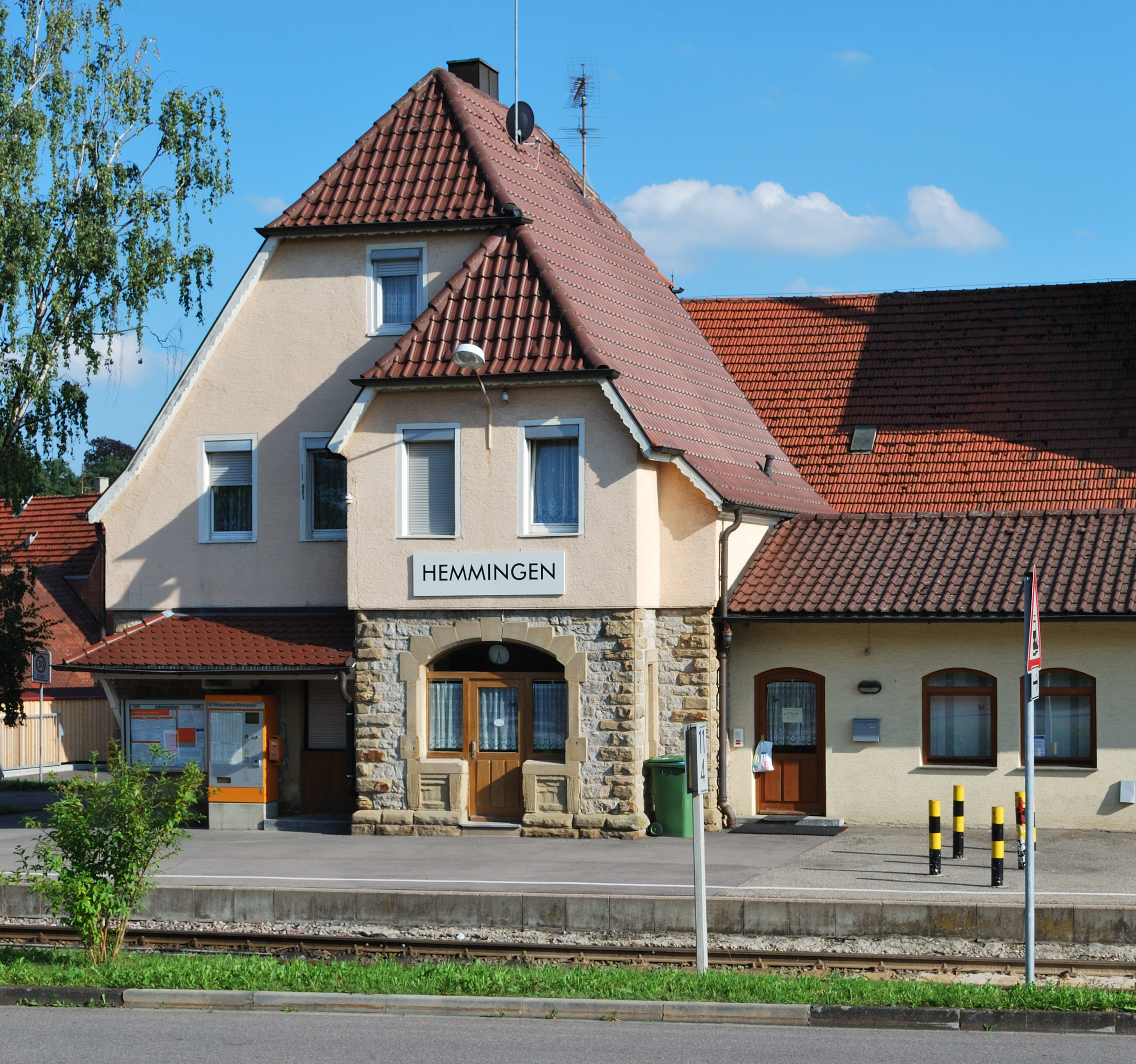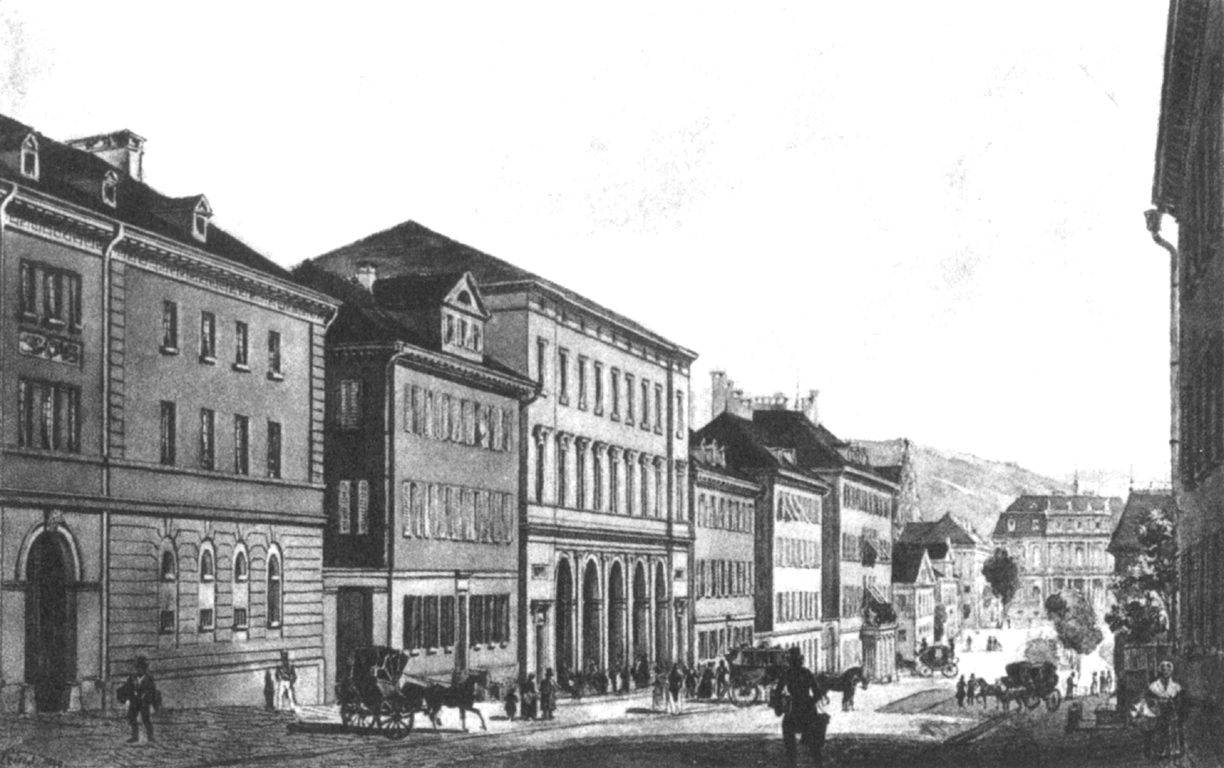|
Schorndorf Station
Schorndorf station is in the city of Schorndorf in the German state of Baden-Württemberg. It was opened in 1861 along with the Rems Railway from Stuttgart to Aalen. The abbreviation of the station is TSF and it is currently used by about 10,000 passengers a day. Location The station is situated on the northern edge of the historic Altstadt of the city of Schorndorf in the centre of the city. Next to the station to its east is the central bus station, to the west was the former freight yard. Layout of the station The station consists of a Renaissance Revival reception building completed in 1863 with some later additions. It has six tracks, namely platform tracks 1–5 and track 14 to the west of the station. Tracks 1–3 and track 5 are in normal use while track 14 is occasionally used for S-Bahn services. Otherwise, this track is mostly used for storing S-Bahn trains. Track 5 is used exclusively for services of the Wieslauf Valley Railway. It is—since the removal of an ea ... [...More Info...] [...Related Items...] OR: [Wikipedia] [Google] [Baidu] |
Schorndorf
Schorndorf is a town in Baden-Württemberg, Germany, located approximately 26 km east of Stuttgart. Its train station is the terminus of the S2 line of the Stuttgart S-Bahn. The town is also sometimes referred to as ' (''The Daimler Town'' in English), as it is the town in which Gottlieb Daimler (1834–1900) was born. Demographics The numbers of inhabitants are estimates, census results (1871–1970 and 1987) or data from statistical office Before 1871 the results are only from the core town. Mayors * 1819–1821: Christian Rapp (politician) (1771–1853) * 1821–1828: Gottlieb Friedrich von Stum (1791–1849) * 1828–1845: Philipp Friedrich Palm (1759–1845) * 1845–1866: * 1866–1872: Johannes Frasch * 1879–1903: Jakob Friz * 1903–1905: Heinrich Beisswanger * 1905–1933: Jakob Raible (1870–1949) * 1933–1945: Richard Beeg (1888–1945) * 1945: Walter Arnold (entrepreneur) (1891–1973) * 1945–1948: Gottlob Kamm (SPD) (1897–1973) * 1948–1954: ... [...More Info...] [...Related Items...] OR: [Wikipedia] [Google] [Baidu] |
Ludwigsburg Station
Ludwigsburg station is in Ludwigsburg in the German state of Baden-Württemberg on the Franconia Railway and the Backnang–Bietigheim line. It is served by regional trains and the Stuttgart S-Bahn. Until 2005 the Ludwigsburg–Markgröningen line also connected to the station. In addition, it has a direct link with Stuttgart's main marshalling yard at Kornwestheim. History From the beginning of the planning for the Central Railway (german: Centralbahn), a station was planned for the ''Residenzstadt'' (city with a royal palace) of Ludwigsburg. Construction began in 1844 and affected several parts of the Ludwigsburg district. A portion of the Lerchenholz hill had to be removed. The site of the former Schafhofseen (lake) had to be filled in. Ludwigsburg station had a two-storey entrance building and a locomotive depot. On 5 October 1846 the first train ran to Ludwigsburg. The stops between Stuttgart and Ludwigsburg were not served by the Royal Württemberg State Railways until ... [...More Info...] [...Related Items...] OR: [Wikipedia] [Google] [Baidu] |
Aalen Hauptbahnhof
Aalen Hauptbahnhof is a junction on the Rems Railway from Stuttgart, the Brenz Railway from Ulm, the Upper Jagst Railway to Crailsheim and Ries Railway to Donauwörth. The station is located 200 metres northeast of the historic old town (Altstadt) of Aalen in the German state of Baden-Württemberg. It is classified by Deutsche Bahn as a category 3 station. Aalen station was renamed a ''Hauptbahnhof'' (main station) at the timetable change on 11 December 2016. History Despite disagreements between the countries of Württemberg and Bavaria, which did not have a common concept of a cross-border railway, the Rems Railway (german: link=no, Remsbahn) was opened by the Royal Württemberg State Railways on 18 July 1861. Aalen was not planned as a railway junction and the station at first was small with eight railway employees who also had postal duties. An extension of the railway towards Nördlingen—now considered part of the Ries Railway (''Riesbahn'')—opened on 3 October 1863 ... [...More Info...] [...Related Items...] OR: [Wikipedia] [Google] [Baidu] |
Schwäbisch Gmünd Station
Schwäbisch Gmünd station was opened in 1861 and is located northwest of the city centre of Schwäbisch Gmünd in the German state of Baden-Württemberg. It is on the Rems Railway (german: Remsbahn) and is a stop for InterCity trains. History Three options were discussed in 1858 for the route of the Rems Railway through the city and the location of the station: *south of the city *north of the city, but south of the Rems *north of the Rems The first options would have meant passing through parks or the built-up area and the future expansion of the city would have been affected. It was decided that the line would run north of the Rems, which meant that the station would be away from the city centre. It also required the relocation of the Rems river, which would protect the city against flooding. Responsibility for the design of the station building was assigned in Württemberg in the 1850s and 1860s to the chief engineer responsible for the construction of the rail track, wh ... [...More Info...] [...Related Items...] OR: [Wikipedia] [Google] [Baidu] |
Rudersberg
Rudersberg is a municipality in the Rems-Murr district, in Baden-Württemberg, Germany. It is located 10 km southeast of Backnang, and 28 km northeast of Stuttgart. Sport The local motocross club ''MSC Wieslauftal'' operates a track near Rudersberg which has in the past been used for Sidecarcross World Championship races. The race has been the final round of the calendar since 2005 and will do so again in 2010 Sidecarcross world championship, 2010, on 12 September. FIM website, accessed: 30 October 2009 References External links MSC Wieslauftal website Rems-Murr-Kreis {{RemsMurr ... [...More Info...] [...Related Items...] OR: [Wikipedia] [Google] [Baidu] |
Württembergische Eisenbahn-Gesellschaft
The Württembergische Eisenbahn-Gesellschaft ("Württemberg Railway Company") or WEG is a transport company in southwest Germany that operates railway lines and services. It is owned by Transdev Germany, itself a subsidiary of the Transdev group. Historically, WEG also operated bus services in the area of its rail services, and WEG branded buses still operate in these areas. However, since 2008 these services have been operated by Omnibus-Verkehr Ruoff GmbH, another subsidiary of Veolia Verkehr GmbH. Lines WEG provides passenger train services on the following railway lines: * : '' Schönbuchbahn'' between Dettenhausen and Böblingen * : '' Strohgäubahn'' between Weissach and Korntal * : '' Wieslauftalbahn'' between Rudersberg- Oberndorf and Schorndorf * : '' Tälesbahn'' between Neuffen and Nürtingen WEG owns and maintains the infrastructure of the ''Strohgäubahn'' and the ''Tälesbahn'', whilst on the ''Schönbuchbahn'' and ''Wieslauftalbahn'' it maintains the infra ... [...More Info...] [...Related Items...] OR: [Wikipedia] [Google] [Baidu] |
Stuttgart S-Bahn
The Stuttgart S-Bahn is a suburban railway system (S-Bahn) serving the Stuttgart Region, an urban agglomeration of around 2.7 million people, consisting of the city of Stuttgart and the adjacent districts of Esslingen, Böblingen, Ludwigsburg and Rems-Murr-Kreis. The Stuttgart S-Bahn comprises seven lines numbered S1 through S6 and S60, and is operated by ''S-Bahn Stuttgart'', a subsidiary of Deutsche Bahn. The system is integrated with the regional transport cooperative, the Verkehrs- und Tarifverbund Stuttgart (VVS), which coordinates tickets and fares among all transport operators in the metropolitan area. Lines All lines lead through the city centre of Stuttgart. The northeastern end of the tunnel (from the tracks near '' Stuttgart Hauptbahnhof'' through '' Schwabstraße'') was the first part of the tunnel to open and has been used since the beginning, the southwestern end from ''Schwabstraße'' through Universität since 1985. The main node to change for ''Stu ... [...More Info...] [...Related Items...] OR: [Wikipedia] [Google] [Baidu] |
Stuttgart Hauptbahnhof
Stuttgart Hauptbahnhof (; en, Stuttgart central station) is the primary railway station in the city of Stuttgart, the state capital of Baden-Württemberg, in southwestern Germany. It is the largest regional and long-distance railway station in Stuttgart, the main node of the Stuttgart S-Bahn network, and, together with the station at Charlottenplatz, it is the main node of the Stuttgart Stadtbahn. Located at the northeastern end of the ''Königstraße'', the main pedestrian zone of the city centre, the main line station is a terminus, whilst the subterranean S-Bahn and Stadtbahn stations are through-stations. The station is well known for its 12-storey tower with a large, rotating and illuminated Mercedes-Benz star insignia on top; the tower and station building are city landmarks. Plans for the controversial Stuttgart 21 project to convert the main line terminus station into an underground through station include the demolition of the side wings of the building, together with ... [...More Info...] [...Related Items...] OR: [Wikipedia] [Google] [Baidu] |
Nürnberg Hauptbahnhof
Nürnberg Hauptbahnhof (German for ''Nuremberg main station'') or Nuremberg Central Station''The train to the plane'' at www.lufthansa.com. Accessed on 7 Oct 2013 at www.dbmuseum.de. Accessed on 7 Oct 2013 is the main railway station serving the city of in . It is the largest station in north |
Karlsruhe Hauptbahnhof
Karlsruhe Hauptbahnhof is a railway station in the German city of Karlsruhe. The station is classified as a Category 1 station, as it is a major hub where several railways connect. History Old station When the Baden Mainline was built between Mannheim and Basel, the original Karlsruhe station was built on Kriegsstraße between Ettlinger Tor and Mendelssohnplatz about 500 metres south of Karlsruher Marktplatz, the central square of Karlsruhe. The station was designed by Friedrich Eisenlohr and it was opened on 1 April 1843 with two platforms. From the beginning, it was designed as a through station. South of the station there was a locomotive depot and to its east there was a freight yard and a central workshop. It was built to Irish gauge (), as were all railways built by the Grand Duchy of Baden State Railway in the early days. It was converted to standard gauge in 1855. In the following years other routes were connected to Karlsruhe station: in 1859 the line to Stuttgart ... [...More Info...] [...Related Items...] OR: [Wikipedia] [Google] [Baidu] |
Intercity (Deutsche Bahn)
Intercity is the second-highest train classification in Germany, after the ICE. Intercity services are loco-hauled express train services, usually over long-distances. There are Intercity routes throughout Germany, and routes generally operate with a two-hour frequency, with multiple routes giving a more frequent service on core routes. Intercity services are operated by the DB Fernverkehr sector of Deutsche Bahn. The ''Intercity'' name was introduced in Germany in 1971, replacing the old F-Zug category, and was the top category of train in Germany until the introduction of the ICEs in the early 1990s. With the proliferation of ICE services, the role of IC trains has diminished slightly, and they have taken on the character of many former InterRegio trains. Nonetheless, Intercity trains still offer a very high standard of speed and comfort – all services convey first class accommodation, and most include catering – usually a Bistro Cafe, but some services include a restaur ... [...More Info...] [...Related Items...] OR: [Wikipedia] [Google] [Baidu] |





.jpg)